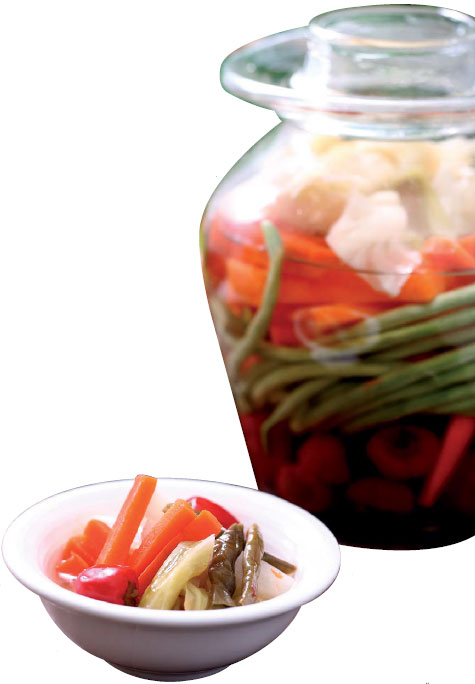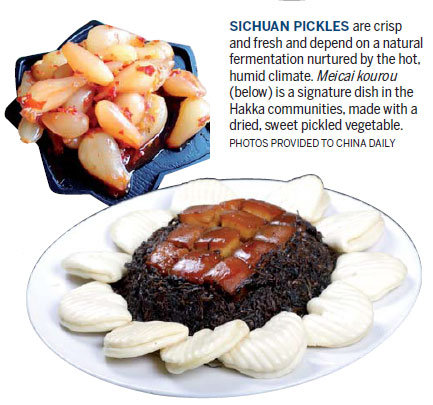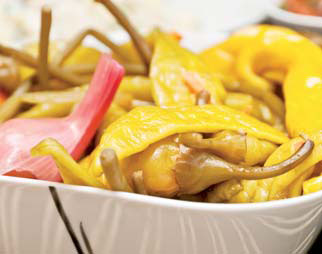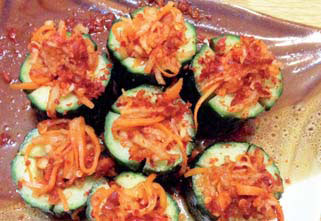Pickles to please the palate

Editor's note: To understand China you have to sit down to eat. Food is the adhesive that holds the Chinese social fabric together. In the face of increasing globalization, food is also one of the last strong visages of community and culture.
In the fields, the grains are slowly setting seed and expanding. The weather, too, is settling into summer heat and humidity. In both city and country, appetites need to be helped along with something tasty, and all across China they have the perfect answer.
Pickles.


From the sour pickled whole cabbages in the north to the salted radishes in central and southern parts, pickles are a major part of every branch of cuisine in China.
Pickles may be sweet, sour, tart, pungent or salty, and their preparation may involve the fermenting of vegetables, fruit, meat or fish - depending on what's available and abundant.
The range is wide and varied, and pickles can be eaten on their own or used as seasoning. Often, they are the result of frugality, used as a means of preserving extra food that cannot be eaten at once.
In certain provinces like Sichuan in the southwest, glass pickle pots are specially designed and may hold anything from pig trotters and chicken claws to chunks of crisp cabbage, carrots, cucumbers and radishes - always spiced with the region's tongue-numbing peppercorns and chili peppers.
Sichuan pickles are crisp and fresh and depend on a natural fermentation nurtured by the hot, humid climate. Once the first batch is successfully produced, the pickling brine is carefully preserved, so successive lots can be started with it.
The main spice used here is the Sichuan peppercorn, which is not a pepper at all but the dried fruit pods of the native prickly ash. It is so spicy that it has almost anesthetic properties.
Blanched chicken claws are a delicacy here, dropped into the pickle pots with small, fiery chili peppers, crisp carrot and radish sticks and plenty of salt and sugar. They may not appeal to Western palates, but they are a favorite snack for many Chinese, easily available even in convenience stores all over the country.
Further south, in Yunnan, the appetites of ethnic groups in the province are whetted by a kaleidoscope of pickles that ranges from finely sliced gingers, bulbs of leeks and tender roots of bellflowers to broad beans and soybeans.
The colorful platters appear as side dishes on the dining table and are enjoyed with the staple rice noodles and pancakes, also made with rice flour. Again, they are bright red with powdered chili peppers.
Another popular pickle ingredient is the white Chinese radish. They are salted and dried whole, cut into batons and dried, or minced and pickled.
These radishes are popular in a swath of provinces ranging from Hubei and Hunan right across to Hebei and Henan, and are used to supplement stir-fries or soups, or used as tasty side dishes.
Mustard greens, a normally bitter-tasting vegetable when fresh, are preserved in brine all across South and Central China to produce more regional specialties. The greens are seldom eaten alone, but they have become a seasoning ingredient that has spawned many famous dishes.
In the Hakka communities in Fujian and Guangdong provinces, a dried, sweet version is steamed slowly with pork belly to produce the signature meicai kourou.
Elsewhere, tart, pickled mustard greens are cooked with fish to produce another famous dish - suancaiyu.
As our culinary journey heads north, the importance of pickles increases. The reason is simple. In the cold, harsh winters in the northeast, the only way to eat any vegetables at all was to pickle them in advance. Although modern logistics mean that fresh greens can now be transported to every corner of China in almost every season, the preserving of vegetables is still very much an annual ritual.
Whole cabbages are pickled in Ali Baba urns large enough to hide a grown man. After some maturing, the vegetables turn tart and pungent and can then be sliced thinly and cooked in winter hotpots with thin slices of meat and handfuls of mung bean vermicelli.
We all know kimchi, that famous vegetable pickle normally associated with Korean cuisine. Few people realize that the Koreans, or chaoxianzu also live as an ethnic group in the northernmost region of China.
Here, before the winter cold hardens the ground, enormous amounts of vegetables are turned into urns of pickles and stored in cellars beneath the earth.
Entire neighborhoods turn out to help one another prepare the season's store of pickles and the occasion may be lifted with spirited songs and dances.
China may have growing pockets of rapid urbanization, but even as city and country integrate in what is still largely an agrarian nation, regional pickles often offer migrant workers of every level something they miss the most - a taste of home.
paulined@chinadaily.com.cn
Sichuan-style vegetable pickles

This is an easy recipe we often prepare at home. Once you have the starter batch fully matured, you can keep adding more ingredients to the jar for a continuing supply of crisp pickles.
1 round cabbage, hard core removed, cut into wedges
2 carrots and 1 whole radish, peeled, cut into batons
Celery stalks, cut into sticks
Pickling mix:
1 star anise, 1 stick cinnamon, 1 tbsp Sichuan peppercorns
3 or 4 small bird's-eye chili peppers
Boiling water
Salt
Prepare a large pickling jar by sterilizing it with boiling water.
Allow more hot water to cool, add to jar.
Add salt to make very light brine.
When liquid is completely cool, add prepared vegetables.
Keep jar in dark, relatively warm place to allow fermentation to start. In summer, it takes only a few days for liquid to sour. You will see tiny bubbles around edge of the jar.
Taste, and if you think vegetables are tart enough, transfer jar into fridge to slow further fermentation. Pickles taste better cold.
Easy cucumber pickles
This is especially good in summer when cucumbers are plentiful. The pickles keep for about a week in the fridge but are best eaten fresh.
2 or 3 dark green cucumbers
Salt
1 apple or pear, skinned and grated
1 small carrot, grated
1 tbsp fish sauce
1 tbsp chili powder
2 cloves garlic, minced
Scatter generous amount of salt on cutting board and roll cucumbers around on salt, pressing down as you roll.
Place cucumbers aside for 30 minutes. Rinse and dry, cut into 5-cm chunks.
Cut a cross on one end of each cucumber chunk. This is where pickling mix will be stuffed.
Combine grated apple or pear, grated carrot, fish sauce, minced garlic and chili powder. Season to taste with a little salt and sugar. Allow to rest for 10 minutes.
Spread open the cut end of cucumber and fill with pickling mix. Set aside in fridge for hour or two, and pickle is ready.

(China Daily European Weekly 04/22/2016 page19)






























